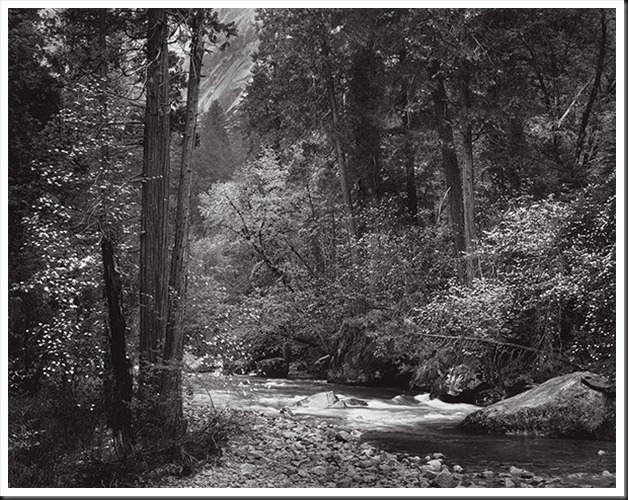As I continue reading Ansel Adam’s fascinating book, ”Examples The Making of 40 Photographs” I continue to come across insights that I wish to share with you.
“Tenaya Creek Dogwood Rain” was taken one overcast spring day in 1948 as Adams was out looking for dogwoods to photograph. He notice something along Tenaya Creek up by Mirror Lake and went exploring. It was starting to rain and he almost returned to his car and the warmth of his accommodation when this scene caught his eye. He went back to his car to retrieve his photographic gear including his 8X10 view camera.
I’m really taken by this photograph. The light is perfect. The white dogwood bracts glow against the green foliage. It has a feeling of both intimacy and grandeur. I would love to have a print. It would be so easy to get lost in it.
The comments that Adams made that caught my attention (besides this beautiful photograph) deal with the inspiration the artist feels when interacting with a subject. They are perfect and I must share them with you.
“The photographer learns to seek the essential qualities of his environment, no matter where he may be. By this I mean he should be tuned to respond to every situation. It is not enough to like or dislike; he must make an effort to understand what he is experiencing…. My life is full of memories of experiences that are of greater importance than recollections of mere things that have happened. Unless I had reacted to the mood of this place with some intensity of feeling, I would have found it a difficult and shallow undertaking to attempt a photograph.”
In my own experience “intensity of feeling” comes with practice, experience, patience, slowing down, quieting the brain, opening up, understanding, respect, harmony, and reverence. There is a very technical, analytical side to photography that can easily drown out the creative, inspirational side. It is necessary to balance the two to create successful images. Technical excellence without soul is sterile and empty. Great photographs begin with inspiration, awe and wonder which is then captured and communicated through an abundance of technical skill. We don’t find inspiration every time we go out but as our eye becomes more and more aware we find inspiration in more and more places.
We invite you to join the conversation. Where do you find inspiration? How has that changed over time? We’d be interested in hearing your experiences.
Do you know someone who might also enjoy this article? Please feel free to share it on Facebook, Twitter or other social network sites.
Join me on an upcoming workshop. Click here for more details.
To see more of my photographs click here.
Oh, by the way, I couldn’t resist. I purchased the photograph from the Ansel Adams Gallery. It will arrive in a few days. I’m so excited.
(4540)

